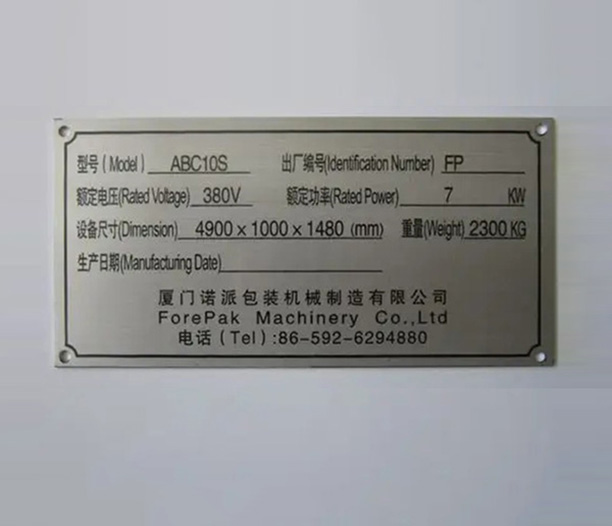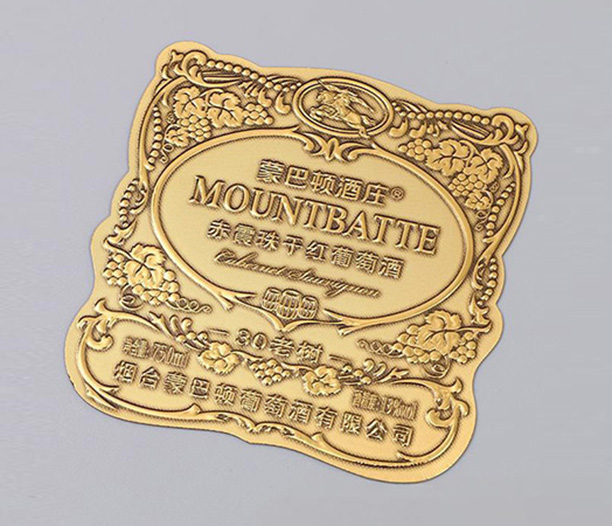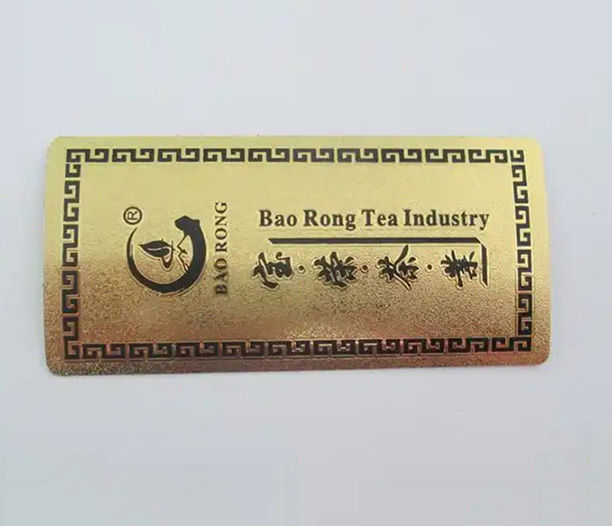In a world where first impressions matter and durability is non-negotiable, custom metal name plates stand as a timeless solution. Far more than simple labels, these pieces are the face of your products, the identifier on your machinery, and the professional touch on your office door. They silently communicate quality, permanence, and attention to detail. Whether you're an engineer finalizing a product prototype, a facilities manager updating a building, or a business owner looking to brand equipment, understanding the ins and outs of custom metal name plates is crucial for making the right choice. This article delves into the materials, processes, and key considerations that will guide you from concept to a finished product that perfectly meets your needs.

What Are Custom Metal Name Plates Really Used For?
The applications for custom metal name plates are nearly endless, spanning across industries and functions. Their primary role is to convey information in a permanent and legible way.
Product Branding and Identification: This is one of the most common uses. A metal name plate affixed to a product displays the brand name, model number, and serial number, creating a professional and established look.
Technical and Compliance Data: For machinery, electrical equipment, and industrial controls, these plates provide essential safety information, voltage ratings, warning labels, and compliance markings (e.g., UL, CE). The durability of metal ensures this critical information remains intact in harsh environments.
Asset Tagging and Tracking: Companies use custom metal name plates as permanent asset tags. Etched or stamped with a unique barcode or QR code, they help in inventory management, theft deterrence, and lifecycle tracking of valuable equipment.
Architectural and Interior Design: From sleek, modern door numbers and room identifiers in corporate buildings to personalized house numbers and plaques for homes, metal name plates add an element of sophistication and clarity.
Awards and Recognition: Trophies, commemorative plaques, and employee recognition awards often utilize high-quality custom metal name plates for their enduring and prestigious qualities.
Choosing the Right Metal for Your Name Plate
The choice of material is the first and most critical step in the process, as it directly impacts the appearance, durability, and cost of your custom metal name plates.
Aluminum: This is a highly popular choice due to its excellent balance of cost, weight, and versatility. Aluminum is lightweight, corrosion-resistant, and accepts a wide variety of finishes, including anodizing (which creates a hard, colored surface) and painting. It's ideal for both indoor and outdoor applications where extreme hardness is not required.
Stainless Steel: Known for its exceptional strength and superior corrosion resistance, stainless steel is the go-to for harsh environments. It’s common in food processing, medical, marine, and chemical industries. It can be polished to a brilliant shine, brushed for a satin finish, or left with a mill finish for a more industrial look.
Brass: If you're aiming for a classic, elegant, or traditional appearance, brass is an excellent option. It develops a distinctive patina over time but can be lacquered to maintain its golden shine. Brass name plates are often used for architectural signage, high-end equipment, and commemorative plaques.
Bronze: Similar to brass but with a richer, darker tone, bronze is synonymous with prestige and longevity. It is heavily used for historical markers, memorials, and high-end architectural applications. Like brass, it patinas naturally unless sealed.
Zinc: While less common on its own, zinc alloys (often die-cast) are used to create custom metal name plates with complex, three-dimensional designs and raised text. They are very durable and are typically plated with chrome, nickel, or brass for appearance.

The Manufacturing Process: How Your Design Becomes Reality
How are these durable plates actually made? Several key processes transform a flat sheet of metal into a finished custom metal name plate.
Photo Etching: This is a highly precise and cost-effective method for producing complex and delicate designs, even in thin materials. A photoresist is applied to the metal, and the design is exposed onto it. Chemicals then etch away the unprotected areas, leaving a precise, burr-free design. It is perfect for barcodes, intricate logos, and thin gauges of metal.
Stamping: For very high-volume runs and designs requiring raised or debossed text, stamping is used. A hardened steel die is created with the inverse of the design and is pressed into the metal with tremendous force. This creates a permanent impression. It is less suitable for low volumes due to high initial tooling costs.
Laser Engraving/Marking: A computer-controlled laser beam removes or alters the surface of the metal to create the design. This process is incredibly accurate, offers great flexibility for customizing serial numbers, and requires no physical contact with the material. It can create high-contrast marks on metals like anodized aluminum and stainless steel.
Screen Printing and Digital Printing: These methods are used to apply ink or coating to the surface of the metal to add color, logos, and text. For long-term durability, the printing is typically protected by a clear coat or overlay. This is an excellent way to add full color to a metal name plate.
Key Factors to Consider When Ordering Custom Metal Name Plates
Before you place an order, answering these questions will ensure you get exactly what you need.
Environment: Will the plate be indoors, outdoors, exposed to chemicals, abrasion, or extreme temperatures? This dictates the best material and finish.
Legibility and Size: How much information needs to be displayed? The size of the plate and the size of the text must be proportional for clear readability.
Attachment Method: How will the plate be mounted? Common methods include adhesive backing (e.g., 3M VHB tape), rivets, screws, or welding studs. The choice depends on the surface material and the need for permanence.
Quantity and Budget: The manufacturing process is often chosen based on the production volume. Photo etching and laser engraving are more economical for low to medium volumes, while stamping becomes viable for very high volumes.
Artwork: Do you have a ready-to-use vector file (e.g., .AI, .EPS, .DXF)? High-quality vector artwork is essential for producing a clean and accurate custom metal name plate.
Finding a Reliable Supplier for Your Project
Not all manufacturers are created equal. Look for a supplier that offers:
Engineering Support: A good supplier will review your artwork and specifications to suggest the most efficient and cost-effective manufacturing solution.
Material and Process Options: They should offer a range of materials and processes to match your specific application.
Quality Assurance: Inquire about their quality control processes to ensure consistency and adherence to specifications.
Samples: The ability to request physical samples before a full production run is a sign of a confident and quality-oriented manufacturer.
Investing time in selecting the right partner for your custom metal name plates will pay dividends in the quality and reliability of the final product.
Frequently Asked Questions (FAQ)
Q1: What file format is best for providing my design for a custom metal name plate?
A1: Vector file formats are essential for producing high-quality custom metal name plates. The best formats are .AI (Adobe Illustrator), .EPS, or .DXF. These files use mathematical paths rather than pixels, allowing the design to be scaled to any size without losing clarity. This ensures your text, logos, and barcodes will be sharp and precise on the final plate.
Q2: How durable are adhesive-backed metal name plates, and will they fall off?
A2: Modern high-performance adhesives, like 3M VHB (Very High Bond) tape, are extremely durable and are designed for permanent bonding. When applied correctly to a clean, smooth, and compatible surface, the bond can be stronger than mechanical fasteners in some applications. They are resistant to moisture, UV light, and temperature fluctuations, making them a reliable and clean alternative to screws or rivets for many uses.
Q3: Can you create multi-colored designs on a single metal name plate?
A3: Yes, it is possible through processes like digital printing or screen printing. Multiple colors can be applied to the metal surface. To protect the colors from wear and abrasion, a protective clear coat or laminate is typically applied over the top. For a different type of color, anodizing aluminum can produce a single, solid, and very durable colored background.
Q4: What is the main difference between etched and stamped metal name plates?
A4: The primary difference lies in the process and the result. Photo etching is a chemical process that removes material to create a design. It is excellent for complex, flat designs and does not stress the metal. Stamping is a mechanical process that uses a die to displace metal, creating raised or recessed areas. Stamping is better for very high volumes and when a tactile, three-dimensional effect is desired, but it involves higher initial tooling costs.
Q5: What is the typical lead time for receiving an order of custom metal name plates?
A5: Lead times can vary significantly based on the manufacturer, the complexity of the design, and the chosen process. A typical lead time for a standard order might range from 1 to 3 weeks. This includes time for reviewing your artwork, producing tooling if necessary (like for etching or stamping), the manufacturing process itself, and quality control. Always discuss timelines with your supplier early in the quoting process.






